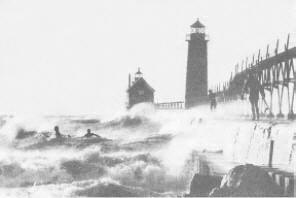
NORTH OTTAWA SHOPPER NEWS November 14, 1978

Great Lakes surfing
Bob Beaton, who has done both, says there are more similarities between freshwater and ocean surfing than differences.
Fresh water provides less buoyancy than salt, and the waves in Lake Michigan tend to be the result of localized wind squalls rather than regular ocean swells, he says, but the basic equipment and techniques used are the same for both.
The wiry Beaton notes that “once or twice a year,” the prevailing winds will create conditions on Lake Michigan very similar to those in the ocean. As a rule though, the shape and size of waves are largely due to daily conditions, rather than geographical areas,” he says.
An important difference between Great Lakes and ocean surfing is that the regularity of the waves in Lake Michigan makes it difficult to paddle out to a suitable depth from shore.
It is for this reason that Beaton and his colleagues choose to surf near the Grand Haven pier when the winds are from the southwest.
They carry their boards to a place short of the lighthouse and jump in.
Beaton warns against neophytes doing the same because of special hazards.
For one, the compression of water created by the waves crashing against the pier generates a rip current similar to the ocean’s. As Beaton explains it the rip current at the pier is like a river running out to sea.
He remembers a time when it was particularly strong and he was caught in it. Frantically, Beaton grasped at the ladders on the pier’s side as he was being swept out to mid-lake. When he was nearly at pier’s end, a monster wave picked him and his board up and hurled them through the uprights of the catwalk “like a human field goal.”
Beaton caught himself on the other edge, minus his surfboard. The force of the wave had torn the safety leash loose, leaving him with nothing but several feet of cord dangling from his ankle.
He pulled himself out of the water and walked to shore. Later, Beaton found his surf board about a mile and a quarter down the channel.
This same compression of water is particularly strong near the rock pile at the foot of the pier. Its intensity, says Beaton, is capable of breaking boards.
When the wind is northwesterly, Port Sheldon is the favored spot for local surfers. Due to the large amount of dredging done by Consumers Power, the waves come out of deep water and hit sand bars in the shallows making what are called “tubes.”

A surfer tries to position his board in a “high energy spot” in the tube and work it until the “close out,” the point at which the wave breaks ahead of the surfer.
As the name suggests, the close out signals the end of a ride. The surfer is, in Beaton’s words, “swallowed up, submerged in a kind of helpless limbo.”
“The wave will take you right to the bottom,” he says. The trick is to get up for air and brace oneself before the next one hits.
The close out usually occurs in about five feet of water, a depth at which, it is too shallow to swim.
Although Beaton claims he has surfed all year around in Lake Michigan, this is the prime season. Surfers wear rubber wet suits and special gloves and footwear to protect themselves from the cold. These are effective, but it is nevertheless wise to spend as little time in the water as possible, waiting for a wave.
A surfer since 1962, Beaton says it has only been in the last five or six years that he has surfed near the pier. He points out that accidents there “have been surprisingly few despite the things that could happen.”